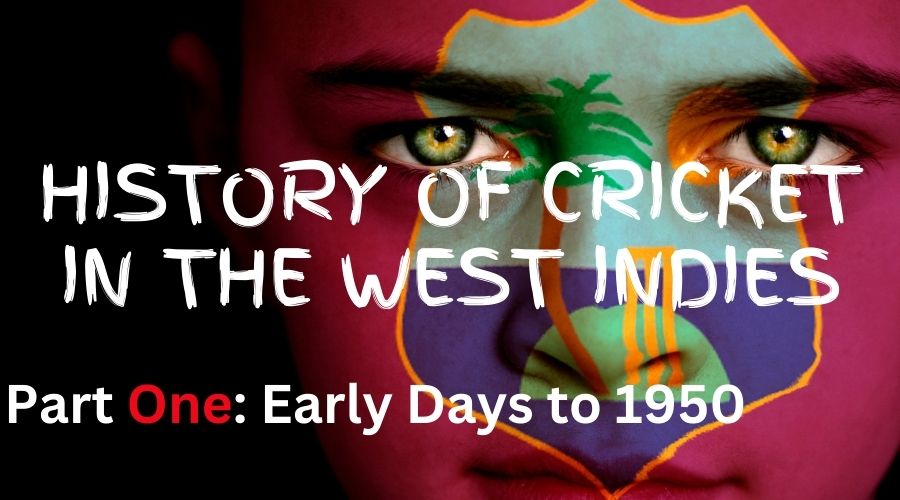Welcome to the first in a series of four posts regarding the History of Cricket in the West Indies. This first part will take you from the early days of cricket before the West Indies’ first test, until the year 1950.
So, stick around, and let’s learn some Calypso Cricket.
Cricket in the West Indies is more than just a sport; it’s a symbol of unity, resilience, and cultural pride.
The history of cricket in the Caribbean is a fascinating journey that began during the colonial era and evolved into a powerhouse of world cricket.
Cricket’s Colonial Roots: The Early Days in the West Indies
The origins of cricket in the West Indies can be traced back to the British colonization of the Caribbean islands. Cricket was introduced to the region by British settlers, military personnel, and colonial administrators in the 18th and 19th centuries. The sport quickly took root in the Caribbean, primarily among the British expatriate communities, who saw it as a way to maintain their cultural ties with the mother country.
In the early days, cricket was played on plantations, in military garrisons, and at social clubs, mostly by the British elite. The game was a reflection of the social hierarchy of the time, with local populations initially having limited access to the sport.
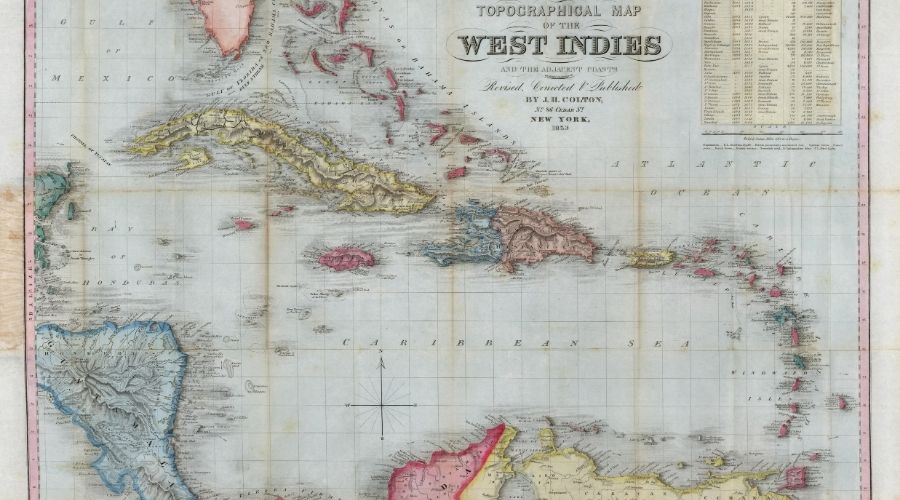
An old map of the West Indies
However, cricket began to spread across the islands, largely due to the efforts of plantation owners who encouraged their workers to play. Matches were often organized on Sundays, and these early games laid the foundation for the sport’s popularity in the region.
The establishment of cricket clubs in major towns and cities, such as Kingston in Jamaica and Bridgetown in Barbados, played a significant role in the development of the game.
These clubs served as hubs for cricketing activity and were instrumental in organizing matches and competitions. As the 19th century progressed, cricket began to transcend its colonial roots, slowly becoming a sport enjoyed by a broader cross-section of society, including the emerging black middle class.
Cricket as the Caribbean’s Favourite Sport
By the late 19th and early 20th centuries, cricket had become the most popular sport in the Caribbean. The game’s appeal grew rapidly, transcending social and racial barriers, and it became a unifying force in the region. Cricket matches were no longer the exclusive domain of the British elite; they were now events where people from all walks of life could come together to celebrate their shared love for the game.
Several factors contributed to the rising popularity of cricket in the West Indies. Firstly, the establishment of schools that included cricket in their curriculum played a crucial role. These schools produced a generation of cricketers who were not only skilled but also passionate about the sport. As more local players began to excel, the game became increasingly associated with Caribbean identity and pride.
Secondly, the influence of social clubs cannot be understated. Clubs such as the Lucas Cricket Club in Jamaica and the Wanderers in Barbados became breeding grounds for local talent. These clubs provided opportunities for players of different backgrounds to compete and hone their skills. The inter-club competitions that emerged during this time were fiercely contested and helped to raise the standard of cricket in the region.
Thirdly, the arrival of touring English teams in the Caribbean sparked greater interest in the sport. These tours provided local players with the opportunity to test their skills against established cricketers from England, and the experience gained from these matches was invaluable. The success of local players in these encounters further fuelled the passion for cricket among the Caribbean population.
As the sport grew in popularity, it began to take on a deeper cultural significance. Cricket became a way for the people of the Caribbean to assert their identity and challenge the colonial power structures that had dominated the region for centuries. The game’s evolution from a colonial pastime to a symbol of Caribbean pride is a testament to the transformative power of sport.
Forming a Single West Indies Team
While cricket was flourishing across the Caribbean, one of the most significant challenges was the formation of a unified West Indies cricket team. The West Indies is a region made up of multiple island nations, each with its own distinct culture, identity, and cricketing traditions. Bringing together players from these diverse islands to form a single team was no small feat.
One of the primary obstacles was the logistical difficulty of organizing inter-island competitions. Travel between the islands was not as straightforward as it is today, and the costs associated with it were prohibitive.
Despite these challenges, there were early attempts to organize inter-island matches, which eventually led to the creation of the Inter-Colonial Tournament in 1891. This tournament, which featured teams from Barbados, British Guiana (now Guyana), and Trinidad, was a significant step towards fostering a sense of regional unity in cricket.
Another challenge was the political and social differences between the islands. The colonial governments of the various islands had different policies and priorities, which often influenced the development of cricket in each territory.
Additionally, there was a sense of rivalry and competition between the islands, which made it difficult to foster a spirit of cooperation. Despite these challenges, the love for cricket was a common thread that bound the islands together.
The formation of the West Indies Cricket Board of Control (WICBC) in the 1920s was a pivotal moment in the history of West Indies cricket. The WICBC was established to oversee the organization and administration of cricket in the region and to represent the West Indies in international cricket. The creation of this governing body was crucial in the effort to unify the islands under one cricketing banner.
The WICBC’s role in bringing together players from the various islands and creating a cohesive team was vital. The board worked to ensure that the best talent from across the Caribbean was selected for the West Indies team, regardless of their island of origin.
This process was not without its challenges, as regional biases and preferences sometimes influenced selection decisions. However, the establishment of a unified team was a significant achievement and laid the groundwork for the West Indies’ future success on the international stage.
The West Indies’ Journey to Test Status
The dream of the West Indies becoming a Test-playing nation was realized in 1928 when they were granted Test status by the Imperial Cricket Conference (now the International Cricket Council). This milestone was the culmination of years of effort by the WICBC and cricketing enthusiasts across the Caribbean. It was a moment of immense pride for the region and marked the beginning of a new era in West Indies cricket.
The journey to Test status was not easy. The West Indies had to prove that they were capable of competing at the highest level, both in terms of skill and organization. The tours by English teams to the Caribbean in the early 20th century played a crucial role in this process. These tours provided the West Indies with the opportunity to showcase their talent and demonstrate that they were ready for the challenges of Test cricket.
When the West Indies played their first Test match against England at Lord’s in June 1928, it was a historic occasion. Although the West Indies lost the match by an innings and 58 runs, the significance of the event was not lost on the players or the Caribbean public.
And even though the West Indies lost their next two tests in that series, also by an innings, the series still marked the beginning of the West Indies’ journey in international cricket and was the first step towards establishing themselves as a formidable force in the sport.
History of Cricket in West Indies – 1930 to 1940
The 1930s were a decade of both growth and struggle for West Indies cricket as the team sought to establish itself on the international stage. Having gained Test status in 1928, the West Indies embarked on several tours during this decade, facing off against England and England. These tours were challenging, as the West Indies were still developing their skills and experience in the longer format of the game.

George Headley, 1930 National Library of Australia, Public domain, via Wikimedia Commons
One of the most significant developments of the 1930s was the emergence of George Headley, who would go on to be known as the “Black Bradman” for his exceptional batting prowess. Headley was a beacon of hope for the West Indies, consistently performing at the highest level despite the team’s struggles.
His ability to score runs against the best bowlers in the world made him one of the most feared batsmen of his time. Headley’s performances were particularly important for the West Indies, as they demonstrated that the team could produce world-class talent capable of competing with the best.
In 22 tests from 1930 to 1954, Headley scored 2190 runs at an average of 60.83, with 10 centuries and 5 fifties. His highest score was 270 not out against England in 1935.
The year 1930 saw the West Indies achieve their first-ever Test victory in their 6th test. Thanks to 209 by Clifford Roach and 114 by George Headley, the West Indies put on a score of 471, and from then on, had the complete run of the test. England could only reply with 145. Instead of enforcing the follow on, a second century (112) by George Headley allowed West Indies to score 290 and set an impossible target of 617, with England falling short by 289.
The West Indies drew this series 1-1.
Their first away victory occurred against Australia the following year, but not before Australia had already won the first 4 tests. And their first series victory happened in the England tour to West Indies in 1935, where West Indies won the 4 test series 2-1.
But still, despite these successes, the West Indies continued to face challenges throughout the decade. The team lacked the depth and consistency needed to consistently challenge the established cricketing powers.
The bowling attack, while capable of brilliance on occasion, was often inconsistent, and the batting lineup heavily relied on Headley to score the bulk of the runs. Additionally, the logistical difficulties of bringing together players from different islands continued to pose challenges for team cohesion and preparation.
The 1930s were also a time of social and political change in the Caribbean. The growing movement for independence and the push for greater social equality had a significant impact on cricket. The sport became a platform for expressing national pride and challenging colonial authority.
By the end of the 1930s, the West Indies had made significant strides in their development as a cricketing nation. While the team was still far from reaching its full potential, the foundations had been laid for future success. The experiences of the 1930s, both the triumphs and the struggles, were crucial in shaping the character and identity of West Indies cricket.
The Stats: West Indian Stats between 1930 and 1940
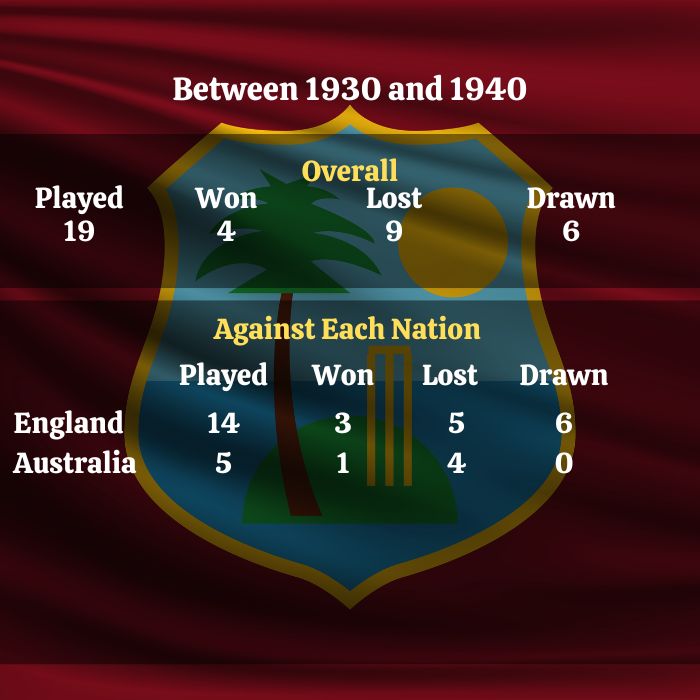
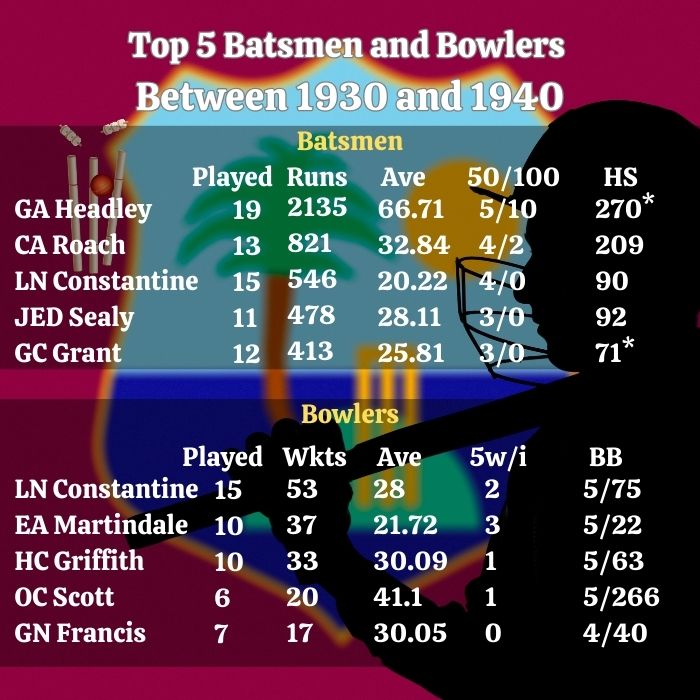
History of Cricket in West Indies – 1940 to 1950
The 1940s were a decade of significant upheaval for cricket in the West Indies, as the sport, like much of the world, was impacted by the events of World War II. The war disrupted international cricket, leading to the cancellation of scheduled tours and the suspension of Test matches. For the West Indies, this period was marked by a lack of international competition, which stalled the progress that had been made in the previous decade.
During the war years, domestic cricket continued in the West Indies, but it was heavily affected by the realities of the global conflict. Many players were enlisted in the armed forces, which depleted the talent pool available for local competitions. Travel restrictions and resource shortages also meant that inter-island competitions were limited, further hindering the development of cricket in the region.
Despite these challenges, cricket remained a crucial part of Caribbean life, serving as a source of solace and continuity during a time of uncertainty. Local matches and club cricket provided an outlet for the cricketing community, and the sport continued to be a focal point of social gatherings and community pride.
As the war came to an end, the focus shifted to rebuilding and revitalizing West Indies cricket. The post-war period saw the resumption of international cricket, and the West Indies were eager to re-establish themselves on the global stage. The late 1940s were a time of transition for the West Indies team, as new players emerged to take up the mantle from the pre-war generation.
One of the key figures in the post-war revival was Clyde Walcott, who would go on to become one of the legendary “Three Ws” of West Indies cricket, alongside Frank Worrell and Everton Weekes.
Walcott made his Test debut in 1948, signalling the arrival of a new generation of West Indian cricketers who would dominate the game in the years to come. His powerful batting and versatility as a wicketkeeper-batsman made him an integral part of the team, and his emergence was a sign of the bright future ahead for West Indies cricket.
In 44 tests, he scored 3,798 runs at an average of 56.68, with 15 centuries and a top score of 220.
Frank Worrell was a stylish right-handed batsman, who also was a very handy left-arm medium pacer. He was the first person to be involved in two partnerships over 500; the first in Bridgetown in 1943-44, in a match between Barbados and Trinidad, where he and JDC Goddard put on 502 not out for the 4th wicket.
Two years later, in a match involving the same two teams, but at Port-of-Spain this time, Worrell partnered with Walcott and put together 574 not out for the fourth wicket.
Worrell played 51 tests, scored 3860 runs at an average of 49.48, with 9 centuries and a top score of 261. He also took 69 wickets at an average of 38.72, with best figures of 7/70.
Winners of Australia v West Indies test series are awarded the Frank Worrell Trophy in honour of his exploits.

Everton Weekes, 1956 Unidentified photographer, Public domain, via Wikimedia Commons
Everton Weekes became knowns as one of the hardest hitters in world cricket, and he owns a particular batting record that even surpasses Don Bradman. He once scored 5 test centuries in 5 consecutive innings, a feat even Don Bradman couldn’t match.
In 48 tests, Weekes scored 4,455 runs at an average of 58.61, with 15 test centuries and a top score of 207.
In terms of test results, the West Indies played only two series, in 1948, they played a 4 test series at home which they won 2-0, and then in 1949, they played a 5 test series against India in India, which they won 1-0.
The 1940s, despite the disruptions caused by the war, were a critical period in the evolution of West Indies cricket. The experiences of the decade, both during the war and in the immediate post-war years, helped to shape the next generation of West Indian cricketers. The challenges faced during this time fostered resilience and adaptability, qualities that would be essential as the West Indies began to assert themselves as a major force in world cricket in the decades that followed.
The Stats: West Indian Stats between 1940 and 1950
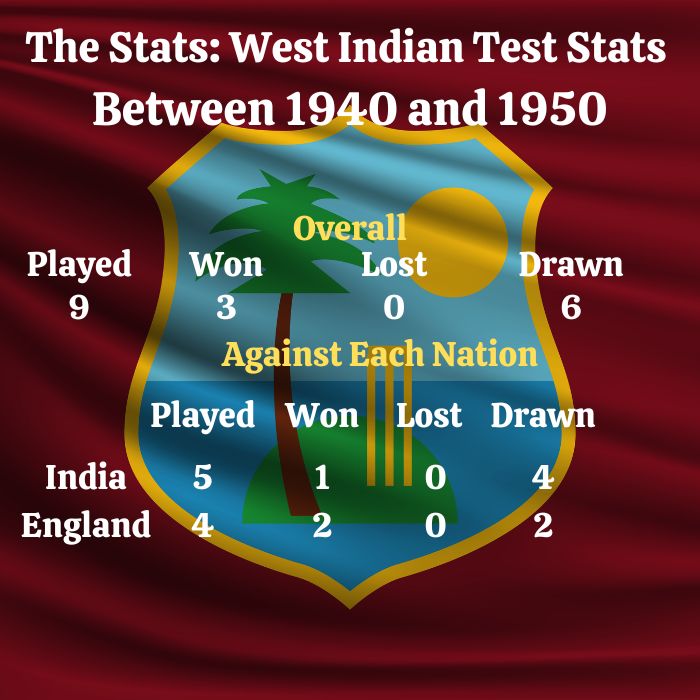
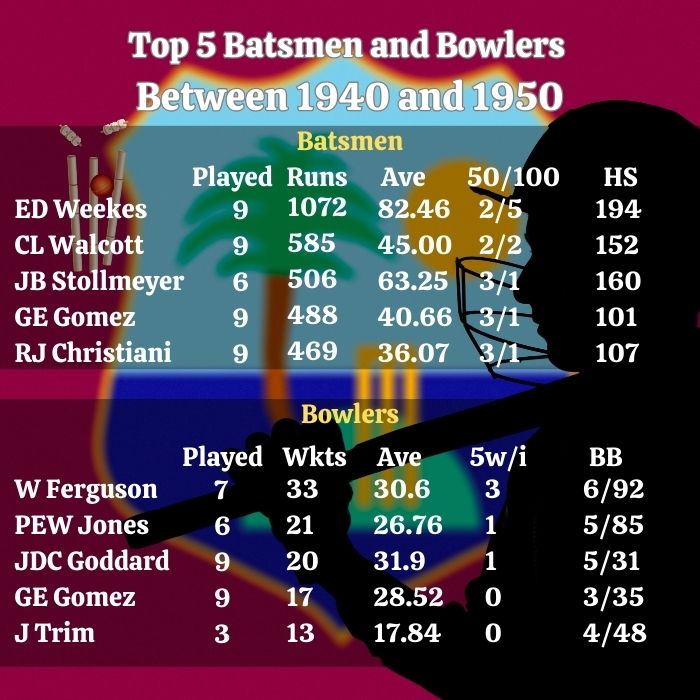
Conclusion
The early years of West Indies cricket, from the late 19th century through the 1940s, laid the groundwork for the remarkable success that the team would achieve in the decades that followed. During this period, the West Indies went through the trials and tribulations of building a unified team, competing on the international stage, and navigating the social and political challenges of the time.
The experiences of these early years were invaluable in shaping the identity and character of West Indies cricket. The struggles to form a cohesive team from the disparate island nations instilled a sense of unity and purpose that would become one of the hallmarks of West Indies cricket.
The early defeats and hard-fought victories against more established cricketing nations taught the team the importance of resilience, adaptability, and continuous improvement.
As the West Indies entered the 1950s, the foundations laid during these formative decades would serve as the bedrock for the team’s rise to dominance. The lessons learned, the talent nurtured, and the cultural significance of cricket in the Caribbean all contributed to the creation of a cricketing powerhouse that would captivate the world in the years to come.
Please return as we continue the series with the next post which will discuss the History of Cricket in the West Indies from 1950 to 1980.

